We Are Proud Of Our SafeSurf Rating!

Meteor Crater Or Barringer Meteorite Crater
Between Flagstaff & Winslow, Arizona
Hikes, Travels, & Tours
Pictures, Photos, Images,& Reviews.
March 16, 2010
George & Eve DeLange
Google Map To Meteor Crater
Between Flagstaff & Winslow, Arizona.
March 16, 2010
Google Map To Meteor Crater
Between Flagstaff & Winslow, Arizona.
View Larger Map


 |
| Meteor Crater. Flagstaff, Arizona. Courtesy: Wikipedia, the free encyclopedia. |
|---|
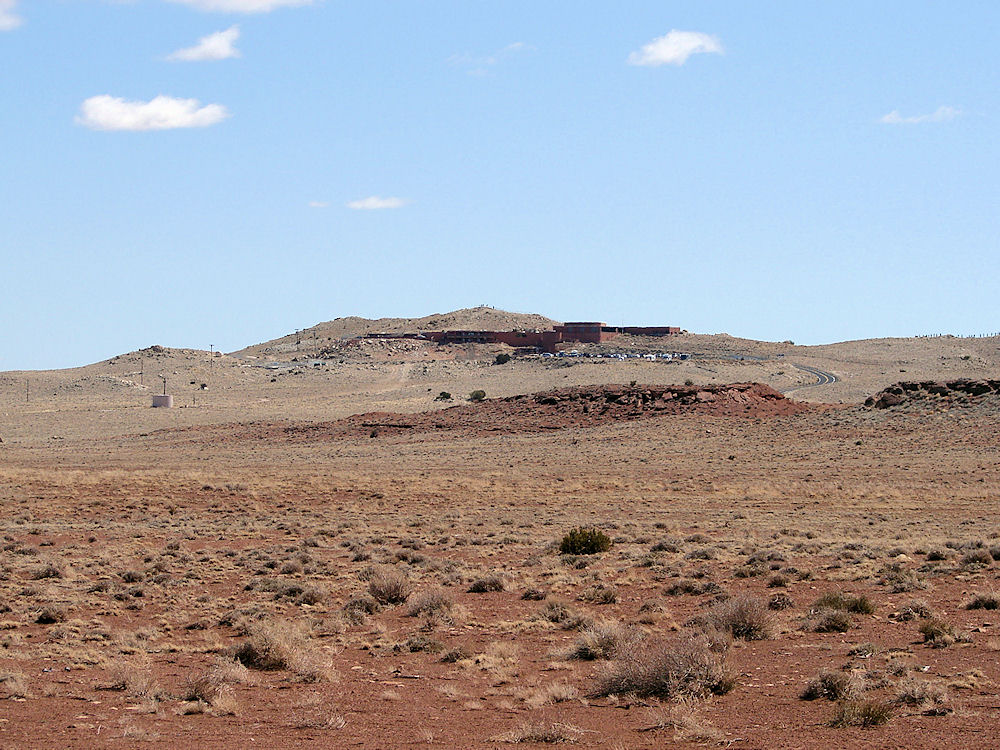 |
| Meteor Crater Visitor Center , Between Flagstaff & Winslow, Arizona. |
|---|
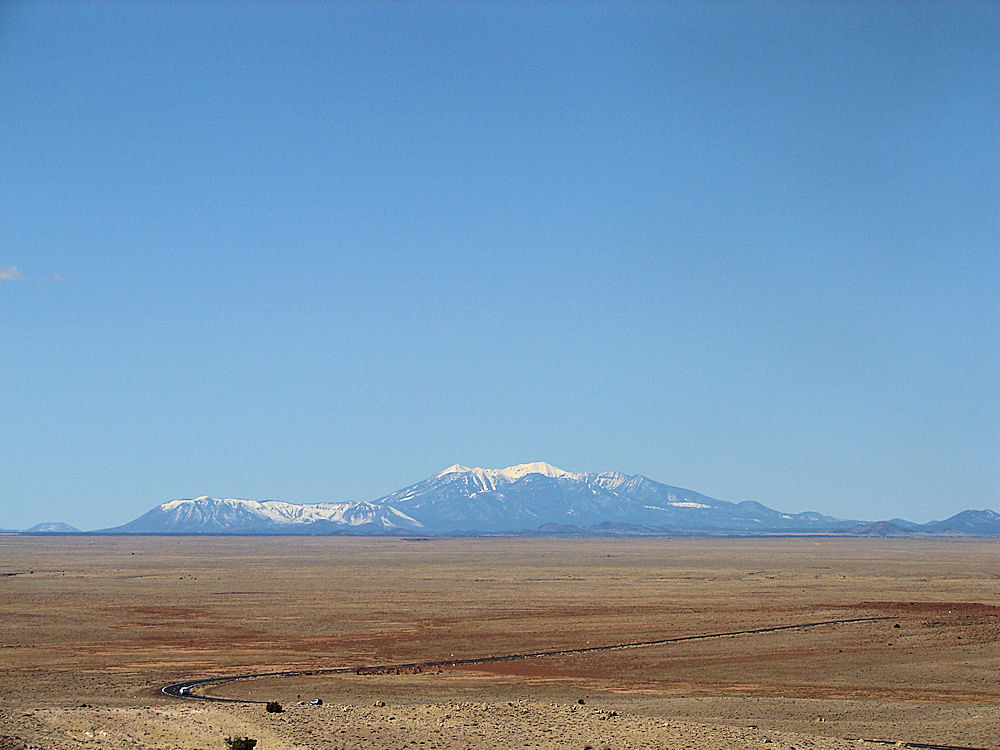 |
| San Francisco Peaks, From The Meteor Crater Visitor Center , Between Flagstaff & Winslow, Arizona. |
 |
| The Basket Meteorite Which Had Been Stolen In 1960. Now Returned To The Meteor Crater Museum. Meteor Crater, Between Flagstaff & Winslow, Arizona. |
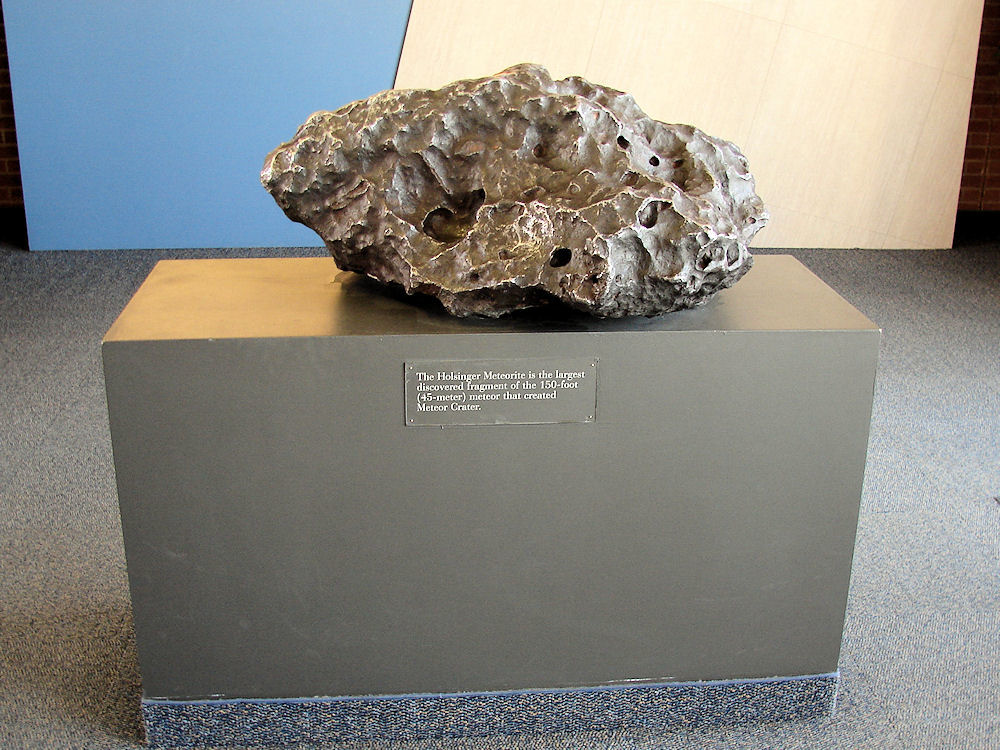 |
| The Holsinger Meteorite Is The Largest Known Fragment Of The Meteorite That Created Meteor Crater. Meteor Crater, Between Flagstaff & Winslow, Arizona. |
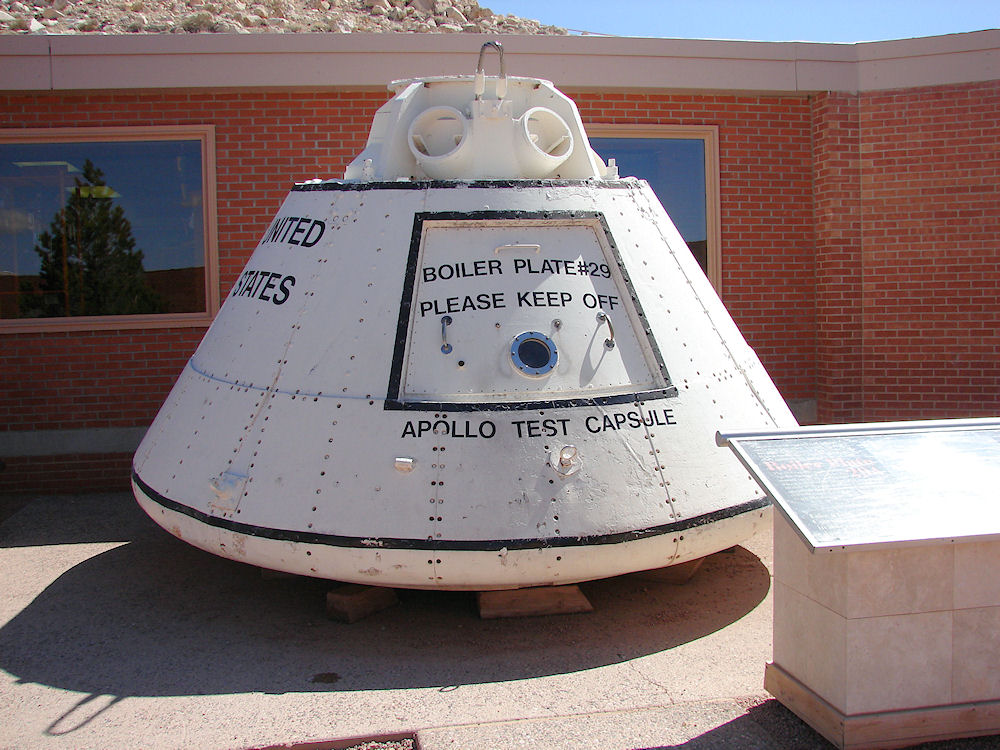 |
| Apollo Test Capsule "Boilerplate-29" at Barringer Crater. Early Test Spacecraft And Mockups Are Usually Called Boilerplate Versions. Made From Steel Plate Used For Ship-Building, Or Pressurized Engine Boilers. Meteor Crater, Between Flagstaff & Winslow, Arizona. |
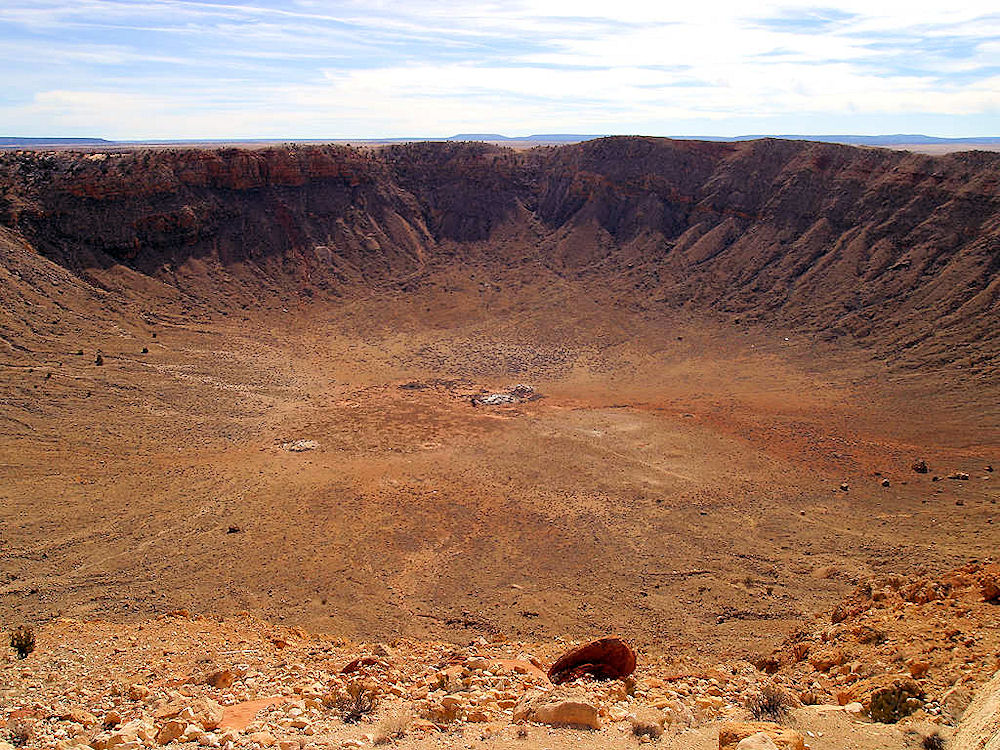 |
| Meteor Crater, Between Flagstaff & Winslow, Arizona. Courtesy: Wikipedia, the free encyclopedia. |
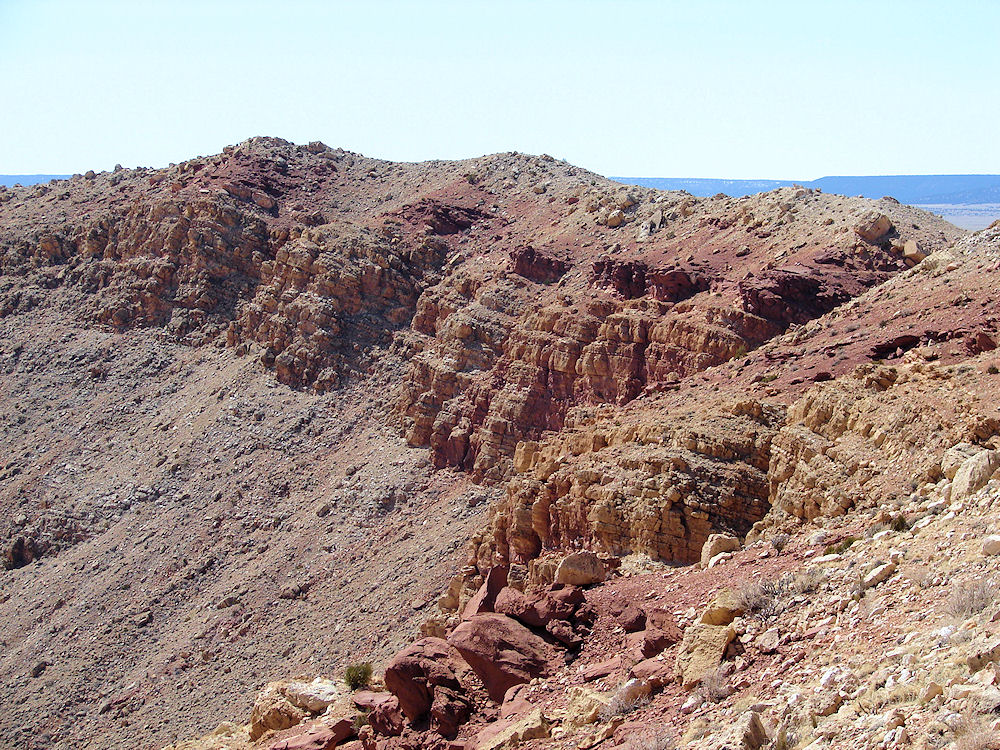 |
| Colorful Moenkopi Formation. Inside Meteor Crater, Between Flagstaff & Winslow, Arizona. |

Meteor Crater is a meteorite impact crater located about 35 miles east of Flagstaff and 20 miles west of Winslow, Arizona in the picturesque high desert. Meteor Crater was established a National Natural Landmark in November of 1967. The site was first known as the Canyon Diablo Crater, and today most scientists generally refer to it as Barringer Crater in honor of Daniel Barringer who was first to suggest that it was produced by meteorite impact. Meteor Crater is privately owned by the Barringer family through their Barringer Crater Company. It was given the name of "Meteor Crater" from the nearby post office named Meteor, since the US Department of the Interior Division of Names generally gives to natural features according to the names of the nearest post office. A Google Earth Map search marks the center of Meteor Crater at about: 35o 01' 37.07" N 111o 01' 21.63" W. At about 5,133 feet elevation. The rim is at about 5,619 elevation. A Google Earth Map search marks the center of the Parking Area of the Meteor Crater Visitor Center at about: 35o 01' 59.78" N 111o 01' 21.30" W. At about 5,605 feet elevation. Meteor Crater is about 4,000 feet in diameter, about 570 feet deep, and it is surrounded by a rim that rises about 150 feet above the surrounding plains. The center of the Meteor Crater is filled with about 700 � 800 feet of rubble lying above the crater bedrock. From the air you can see one of the interesting features of the crater as its squared - off outline, which is believed to be caused by the pre - existing regional jointing or cracks in the strata at the impact site. The speed of the impact has been a subject of some debate. The crater was created about 50,000 years ago bt a piece of an asteroid traveling at about 26,000 miles per hour and striking planet Earth; during the Pleistocene epoch when the local climate on the Colorado Plateau was much cooler and damper. The area was also an open grassland dotted with woodlands thought to be inhabited by woolly mammoths, giant ground sloths, and camels. The meteorite that excavated the crater was a nickel-iron meteorite about 162 feet in diameter. It is thought that about 1/2 of the meteorites weight was vaporized during its descent, before it ever hit the ground. Very little of the meteorite actually remained within the crater that it had created. Many years ago when it was lawful to explore the crater, George DeLange found melted sand which had formed into glass at the bottom of the crater. This had come from the heat of the impact. Also many fragments of the meteorite could be found for about 5 miles around the crater. When it was discovered by European settlers in the 19th century; it was named the Canyon Diablo crater, it also was ascribed to the actions of a volcano. This was not an unreasonable assumption, since the San Francisco volcanic field lies only about 40 miles to the west. In 1891 Grove Karl Gilbert, the chief geologist for the U.S. Geological Survey, investigated the crater and concluded that it was the result of a volcanic steam explosion. In 1903, mining engineer and businessman Daniel M. Barringer thought that the crater had been produced by the impact of a large iron-metallic meteorite. His company, the Standard Iron Company, received a patent signed by Theodore Roosevelt for 640 acres around the center of the crater in 1903. The claim was divided into four quadrants coming from the center clockwise from northwest named Venus, Mars, Jupiter and Saturn. Barringer's company, the Standard Iron Company conducted research on the crater's origins between the years 1903 and 1905. Barringer concluded that the crater had indeed been caused by a meteorite impact. Barringer and his partner, the mathematician and physicist Benjamin Chew Tilghman, presented evidence for the impact theory to the U.S. Geological Survey in 1906 and their theory was published in the Proceedings of the Academy of Natural Sciences in Philadelphia. Barringer's arguments were met with skepticism but as time went on, the concept became more acceptable as planetary science gained in maturity and understanding. Then in about 1960, Eugene Merle Shoemaker (or Gene Shoemaker) (April 28, 1928 � July 18, 1997), an acquaintance of George DeLange, the author of this page, presented research which would confirm Barringer's hypothesis. Eugene Merle Shoemaker's key discovery was the presence in the crater of the mineral stishovite, a rare form of silica found only where quartz-bearing rocks have been severely shocked by an instantaneous overpressure. Stishovite cannot be created by volcanic action; the only known mechanism of creating it is through an impact event (or artificially through a nuclear explosion). A visitor center operated by Meteor Crater Enterprises stands on the north rim of the crater. The Meteor Crater Visitor Center features interactive exhibits and displays about meteorites and asteroids, space, the solar system and comets. The Visitor Center features the American Astronaut Wall of Fame, and such artifacts on display as an Apollo program test space capsule, a 1,406 pound meteorite found in the area, and meteorite specimens from Meteor Crater that can be touched. Formerly known as the Museum of Astrogeology, the Visitor Center includes a movie theater, a gift shop, and observation areas with views inside the rim of the crater. Guided tours of the rim are offered daily. Various layers of the exposed limestone and sandstone can be seen just beneath the crater rim, as well as large stone blocks excavated by the impact. The impact of the meteorite created an inverted topography to the land so that the layers immediately exterior to the rim are stacked in opposite order in which they normally occur. If fact, the impact overturned and inverted the layers to a distance of about one to two kilometers outward from the crater's edge.
When climbing the OUTSIDE rim of the crater the layers are as follow:
When climbing the INSIDE rim of the crater the layers are in the normal order.
How To Contact Meteor Crater Enterprises, Inc.:
Meteor Crater Enterprises, Inc.:
Meteor Crater Visitor Center is open daily. Visitation hours are as follows:
Hours:
Admission Prices:
RV Park Site:
Be prepared for variable and extreme weather conditions: snow in winter, hot sun in summer with afternoon thunderstorms from Mid June To Mid September. Especially during spring, strong gusty winds on the rim and/or in the canyon. Pets are not allowed on the trails, in the backcountry, in buildings, or tied to objects in the area. They are welcome in the parking areas on a leash. Warning: Summer temperatures may be fatal to pets left in vehicles. How To Get There: From Phoenix. Take I-17 North. On I-17, Take exit 340A to merge onto I-40 E toward Albuquerque 38.2 miles. Then take exit 233 for Meteor Crater Rd 0.3 mile. Then turn right at Meteor Crater Rd. Destination will be on the right 5.4 miles. Then you are at the Visitor Center. The trip is about 179 miles and takes about 2 hours 57 minutes from Phoenix.
We have enjoyed this beautiful place since about 1945.
|
If you are planning to visit Meteor Crater. And if you are coming from outside of Arizona, you could fly into Flagstaff, Arizona and then rent a car. You also could fly into the Phoenix Sky Harbor International Airport and drive the 144 miles to Flagstaff. Take the I-17 north to Flagstaff. I-17 will end and turn into Milton Road, leading you into Flagstaff. A trip of 144 miles (232 km) - 2 hours. There is a Sky Harbor - Flagstaff flight that can be arranged. There is also a Sky Harbor - Flagstaff shuttle. There are many hotels and motels in both areas and if you need a place to stay; Priceline.com can arrange that for you. We have some links to Priceline.com on this page since they can arrange all of your air flights, hotels and car. In addition, you may need to purchase some outdoor camping gear and clothing. We also have some links to Altrec.com on this page since they are a good online source for any outdoor camping gear and clothing that you may need. We of course, appreciate your use of the advertising on our pages, since it helps us to keep our pages active.
|
| Meteor Crater | Meteor Crater |
|---|

We Are Proud Of Our SafeSurf Rating!

Click On Any Of The Following Links By Amazon.Com
For Books, & Videos About Meteor Crater. No Obligation!
Click On Any Of The Following Links By Amazon.Com
For Books Or Videos About Telescopes, No Obligation!
You Will Leave deLange.org



